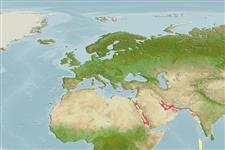>
Tetraodontiformes (Puffers and filefishes) >
Monacanthidae (Filefishes)
Etymology: Oxymonacanthus: Greek, oxys = sharp + Greek, monos = one + Greek, akantha = thorn (Ref. 45335).
Environment: milieu / climate zone / depth range / distribution range
Οικολογία
Θαλασσινό(ά) Υφαλόφιλο(α); εύρος βάθους ? - 10 m (Ref. 100374). Tropical
Western Indian Ocean: Red Sea.
Μέγεθος / Βάρος / Age
Maturity: Lm ? range ? - ? cm
Max length : 7.0 cm TL αρσενικό/απροσδιόριστο; (Ref. 8883)
Inhabits coral rich fringing reefs and feeds on Acropora polyps (Ref. 9710).
Life cycle and mating behavior
Maturities | Αναπαραγωγή | Spawnings | Egg(s) | Fecundities | Προνύμφες
Randall, J.E., 1986. Red Sea reef fishes. London, Immel Publishing. 192 p. (Ref. 8883)
IUCN Red List Status (Ref. 130435)
Threat to humans
Harmless
Human uses
Εργαλεία
Special reports
Download XML
Διαδικτυακές πηγές
Estimates based on models
Preferred temperature (Ref.
123201): 24.5 - 29.2, mean 27.2 °C (based on 108 cells).
Phylogenetic diversity index (Ref.
82804): PD
50 = 0.7500 [Uniqueness, from 0.5 = low to 2.0 = high].
Bayesian length-weight: a=0.01047 (0.00417 - 0.02629), b=3.06 (2.85 - 3.27), in cm total length, based on LWR estimates for this (Sub)family-body shape (Ref.
93245).
Τροφικό Επίπεδο (Ref.
69278): 3.6 ±0.50 se; based on food items.
Ελαστικότητα (Ref.
120179): Υψηλό, ελάχιστος χρόνος για διπλασιασμό πληθυσμού < 15 μήνες (Preliminary K or Fecundity.).
Fishing Vulnerability (Ref.
59153): Low vulnerability (10 of 100).
